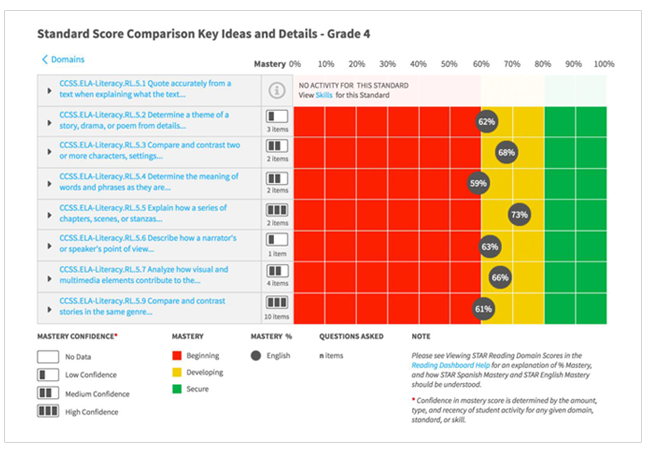September 14, 2017
Previously, we explored distinctions between proficiency and growth. Proficiency, from its Latin origin, means “to accomplish or make progress.” Accomplishments in the education setting are generally described as reaching an established performance benchmark. Most commonly, this benchmark represents a minimally acceptable level of student performance at a certain grade level in a specific discipline. Proficiency represents “good enough for now.”
While “proficiency” comes to us courtesy of the Romans, the French gave us “mastery,” which they describe as “intellectual command.” Not just “good enough” but a confident, authoritative grasp of learning. We often speak of mastery in pursuits beyond school. For example, professional athletes are described as having physical command, singers at the top of their game demonstrate vocal command, and effective leaders showcase their tactical command. With all this command going around, is it enough for our scholars to simply make progress, or does each one deserve the opportunity to develop intellectual command?
Intellectual command
One of the earliest documented attempts at mastery learning in the United States was implemented in the San Francisco Normal School in 1912. In this model, students had to show evidence of mastery rather than via the dual requirement of fulfilling an established amount of time and a minimally-acceptable degree of knowledge.
The San Francisco model was not sustainable, due in part to the extensive amount of data and analysis required to fuel it. The roaring 1920s ushered in two additional efforts to implement mastery learning: the Winnetka Plan and work by the University of Chicago Laboratory School (Block, 1971; Washburne, 1922). Like the San Francisco model, neither one was sustainable. Additional efforts toward mastery continued throughout the 20th century (Bloom, 1968; 1972), each with similar challenges related to data-management technologies (or the lack thereof). Regardless, mastery remains at the heart of many of education’s boldest ideals, e.g. Response to Intervention and personalization.
Instructional command
If mastery is intellectual command, then guiding students to it requires instructional command. Recently, I asked a true artisan to describe her journey toward mastery. She mentioned three key elements:
- Vision—see what needs to be done.
- Others—seek guidance from mentors and colleagues.
- Mistakes—grow from what could be done better.
Educators with instructional command have a deep understanding of students’ work with mentors and peers. Further, the emphasis over the past decade on resiliency, failing forward, and growth mindsets makes clear the power of paying attention to, and learning from, mistakes. However, there may be a place in the discussion to think more about vision and its role in instructional command and mastery learning.
With something as infinitely complex as guiding students toward making meaning from text or solving problems with symbolic representations, a vision of how learning happens is critical. A learning progression, such as Renaissance Core Progress Reading® or Renaissance Core Progress Math®, clearly lays out the skills and subskills required to master the domains of reading and mathematics in the order in which they are most commonly learned. Empirical testing found a strong statistical link between the progression of skills in these learning progressions and the assessed difficulty levels of Renaissance Star 360® items, making these learning progressions the “backbone” for Renaissance Star Assessments®. This means that educators can use scores from these assessments to see what students know and what they are ready to learn (Renaissance, 2017). This is vision. Using that vision to identify resources and design lessons for students based on what they know and what they are ready to learn is instructional command.
Renaissance mastery view

In addition to the vision required to understand where students are and what they are ready to learn, teachers need tools to visualize student progress toward mastery in specific areas of learning. The Renaissance mastery-view series of dashboards automatically tracks and reports information about a student’s performance by domain, standard, skill area, skill, or subskill (Renaissance, 2016). Within these dashboards, student performance is visualized in three key stages:
- Beginning mastery—the first steps in learning are among the most critical. Students in the beginning mastery stage have achieved up to 59 percent mastery.
- Developing mastery—as knowledge deepens, students develop greater understanding of skills and subskills and have achieved up to 79 percent mastery in that skill area, skill, or subskill.
- Secure mastery—as students reach 80–100 percent mastery, they secure and maintain their knowledge.
Many teachers guide students to visualize their mastery—their continually refining intellectual command—via the Renaissance mastery view.
Command is all that is truly good enough
We began this discussion by questioning whether “good enough” is good enough. Is it good enough for now, or do the data-acquisition, analysis, and management tools exist to allow meaningful efforts toward intellectual and instructional command?
Also visit our EdWords™ page to browse our discussions of key education ideas—from personalized learning to productive struggle, we think it through and share our thoughts.
References
Blatchford, R. (2015). Differentiation is out. Mastery is the new classroom buzzword. The Guardian online. Retrieved from https://www.theguardian.com/teacher-network/2015/oct/01/mastery-differentiation-new-classroom-buzzword
Bloom, B. S. (1968). Learning for mastery. Evaluation Comment, 1(2), 1–5.
Bloom, B. S. (1976). Human characteristics and school learning, New York, NY: McGraw-Hill.
Block, J. (1971). Mastery learning theory and practice. Holt, Rinehart, & Winston.
Cooper, A. How personalized learning stars with less teacher talk and more student voice. EdSurge. Retrieved https://www.edsurge.com/news/2017-01-25-how-personalized-learning-starts-with-less-teacher-talk-more-student-voice
Renaissance (2016). Special Report: The Renaissance mastery model. Retrieved from https://www.renaissance.com/lp/renaissance-mastery-model/
Renaissance (2017). The next generation of Response to Intervention. Retrieved from https://www.renaissance.com/lp/next-generation-of-rti/
Washburne, C. W. (1922). Educational measurements as a key to individual instruction and promotions. Journal of Educational Research, 5(3), 195–206.
Wiliam, D. (2011) Embedded formative assessment. Solution Tree Press, Bloomington IN


